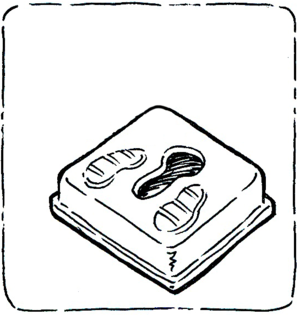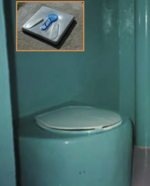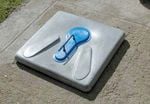
A Dry Toilet is a toilet that operates without water. The Dry Toilet may be a raised pedestal that the user can sit on, or a squat pan that the user squats over. In both cases, excreta (both urine and faeces) fall through a drop hole.
Here, a Dry Toilet refers specifically to the device that the user sits or squats over. In other literature, a Dry Toilet may refer to a variety of technologies, or combinations of technologies (especially pits).
The Dry Toilet is usually placed over a pit; if two pits are used, the pedestal or slab should be designed in such a way that it can be lifted and moved from one pit to another.
The slab or pedestal base should be well sized to the pit so that it is both safe for the user and prevents stormwater from infiltrating the pit (which may cause it to overflow).
Composting and fertilization are important steps to organic farming and gardens. In order to get the level of nitrogen needed, one may use a waterless toilet and add the product to their compost pile.
| Advantages | Disadvantages |
|---|---|
- Does not require a constant source of water.
|
- Odours are normally noticeable (even if the vault or pit used to collect excreta is equipped with a vent pipe).
|
Definitions[edit | edit source]


- Waterless Toilet- Consists of two or more 5-gallon buckets, sawdust or other organic material (lime or wood chips), and a toilet seat. Since it does not use water like the toilets that most of us know, they save clean water, a limited resource.
- Humanure- provides valuable source of nutrients needed for compost. It contains high levels of nitrogen and is easily collected using a waterless toilet.
- Compost- also called humus, an organic fertilizer which replenishes and improves the quality of soil. This type of fertilization is useful in areas where there is no money to spend on expensive fertilizers and pesticides. Organic farms or gardens can use this too in order to have a healthy growth of plants.
Adequacy[edit | edit source]
Dry Toilets are easy for almost everyone to use. Because there is no need to separate urine and faeces, they are often the most physically comfortable and natural option.
Pedestals and squatting slabs can be made locally with concrete (providing that sand and cement are available). Wooden or metal molds can be used to produce several units quickly and efficiently. When dry toilets are made locally, they can be specially designed to meet the needs of the target users (e.g. smaller ones for children). Fibreglass, porcelain and stainless steel versions may also be available. They are appropriate for almost every climate.
Composting process[edit | edit source]
Depending on your location, the composting process can take from three months to a few years depending on climate, temperature and composting system. There are two ways to kill the pathogens in the waste. One method is to allow the waste to be a low-temperature where it is left long enough for the pathogens to break down naturally. There are also hot, thermophilic toilets which heat the waste to a temperature high enough to kill the pathogens.
In order to preserve the majority of nitrogen (90%) and phosphorus (70%) it is important to preserve the urine. An advantage to this method of composting toilet is that it saves these valuable nutrients for reuse instead of allowing them to leach into the groundwater.
The composting process requires a temperature range between ?°C and ?°C.
The composting requires about nine months to be thorough eliminatinate all existing pathogens. The compost produced is an almost dry, crumbly, black product having a light, pleasant, earthy odour.
Maintenance[edit | edit source]
The sitting or standing surface should be kept clean and dry to prevent pathogen/disease transmission and to limit odours.
There are no mechanical parts and so the Dry Toilet should not need repairs except in the event that it cracks.
Health Aspects / Acceptance[edit | edit source]
Squatting is a natural position for many people and so a well-kept squatting slab may be the most acceptable option.
Since Dry Toilets do not have a water seal, odours may be a problem depending on the Collection and Storage/ Treatment technology to which it is connected.
Safety and risk[edit | edit source]
Stenström[1] et al conducted a risk assessment of many common components used in WASH systems. They concluded that the dry toilet (as a 'user interface technology') represents a high risk of daily infection for users where the toilets were dirty, much reduced if cleaner and handwashing is practiced. There is a regular medium risk of infection for workers who clean the toilets, but this can be high after an incidence of diarrhea.
Given that all toilets must be connected to some kind of latrine or disposal system, this cannot be considered to be the total risk associated with a dry toilet system.
For more discussion on these issues, see Infection risk from Ecosan
Social context[edit | edit source]
In America people are less likely to use this method of conservation because of their extraordinarily high standard of living. This would be very useful in many parts of America, especially in the areas where there is seasonal water shortage. Droughts would not affect the area as much if everyone used this type of toilet because of the water saved from using the waterless toilet.
There are many examples of waterless toilets being used around the world. The C.K. Choi Building at the University of British Columbia contains ten composting toilets which are used for 300 full time employees. Also the IslandWood School on Bainbridge Island in Washington relies soley on composting toilets. Although the composting toilets that are used in these buildings are not as simple as the waterless toilet that is explained in this article, they are useful and more sanitary for the large number of people who use them.
The method explained in this article is more likely to work in less developed countries. Some places are currently using latrines and other methods of waterless toilets, so they would gain from their wastes being used as compost material and enriching their soil.
Manuals, videos, and links[edit | edit source]
- Dry toilet Demonstration of SanPlat system.
- http://web.archive.org/web/20090124085238/http://www.sanplat.com:80/sharewar.htm Manual for building SanPlat-type dry toilets.
Acknowledgements[edit | edit source]
The material on this page was adapted from:
Tilley, E. et al. (2008). Compendium of Sanitation Systems and Technologies, published by Sandec, the Department of Water and Sanitation in Developing Countries of Eawag, the Swiss Federal Institute of Aquatic Science and Technology, Dübendorf, Switzerland.
The publication is available in English, French, and will be made available in Spanish. Available in the IRC Digital Library
See also[edit | edit source]
References[edit | edit source]
- Brandberg, B. (1997). Latrine Building. A Handbook for Implementation of the Sanplat System. Intermediate Technology Publications, London. pp 55–77 (Describes how to build a squatting slab and the moulds for the frame, footrests, spacers, etc.)
- Morgan, P. (2007). Toilets That Make Compost: Low-cost, sanitary toilets that produce valuable compost for crops in an African context. Stockholm Environment Institute, Sweden. (Excellent description of how to make support rings and squatting slabs (pages 7–35) and pedestals (39–43) using only sand, cement, plastic sheeting and wire.) Available: www.ecosanres.org
- Squatting plates www.sanplat.com
- Netherlands Water Partnership (NWP) (2006). Smart Sanitation Solutions. Examples of innovative, low-cost technologies for toilets, collection, transportation, treatment and use of sanitation products. NWP, Netherlands. (Provides country specific data and links for further information.)
- Composting Toilet World "An Introduction," 2007. Available: http://compostingtoilet.org/compost_toilets_explained/what_is_a_composting_toilet/index.php
This fully editable article includes content from an original document. The ported version of the original document is protected at this page Recycling agricultural wastes to produce hot water (original)